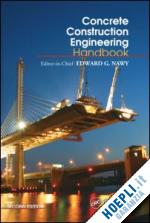Concrete Constituent Materials, S. Mindess Introduction Portland Cement Modified Portland Cements High-Alumina Cement 1Performance of Different Cements in Concrete Water Water/Cement Ratio Aggregates Reinforcement Durability Considerations Mineral Admixtures, V.M. Malhotra Fly Ash Blast-Furnace Slag Silica Fume Highly Reactive Metakaolin Chemical Admixtures, D.P. Whitney Introduction to Chemical Admixtures Retarding Admixtures Water-Range Water-Reducing Admixtures High-range Water-Reducing Admixtures Accelerating Admixtures Air-Entraining Admixtures Antifreezing Admixtures Antiwashout Admixtures Shrinkage-Reducing Admixtures Polymer Modifiers and Binder Systems Alkali Silica Reaction Prevention admixtures Conclusion Long Term Effects and Serviceability, E.G. Nawy and H. Nassif Creep Deformations in Concrete Creep Prediction Shrinkage in Concrete Strength and Elastic Properties of Concrete versus Time Serviceability Long-Term Considerations Serviceability Long-term Considerations Long-term Shrinkage and temperature Reinforcement Controlling Cracking Autogenous Shrinkage Properties and Performance of Normal-Strength and High-Strength Concrete, S.H. Kosmatka Introduction Workability, Bleeding, and Consolidation Mixing, Transporting, and Placing Concrete Permeability Carbonation Early Age Characteristics and Strength Density Abrasion Resistance Volume Change and Crack Control Deformation and Creep Concrete Ingredients Proportioning of Concrete Mixtures Hot and Cold Weather Concreting Control Tests Freeze-Thaw and Deicer Scaling Resistance Sulfate-Resistant Concrete Corrosion Protection Alkali-Silica Reaction Related Standards Part A: Design of Concrete Mixtures, E.G. Nawy General Selection of Constituent Materials Mixture Proportioning for High-Performance Normal-Strength Concrete (Compressive Cylinder Strength Limit 6000 psi) Mixture Proportioning for High-Performance High-Strength Concrete (Cylinder Compressive Strength Exceeding 6000 psi) Part B: Applications and Constructability, J. Moreno and J. Albinger Applications and Constructability with an Emphasis on High-Strength High-Performance Concrete Job-Site Control Testing Design and Construction of Concrete Formwork, D.W. Johnston Introduction Types of Formwork Formwork Standards and Recommended Practices Loads and Pressure on Formwork Formwork Design Criteria Formwork Design Slab-Form Design Example Wall-Form Design Example Construction Loading in High-Rise Buildings, S. K. Ghosh Introduction Construction Loads Properties of Concrete at Early Ages Strength Consequences of Construction Loads Serviceability Consequences of Construction Loads Codes and Standards Deflection of Concrete Members, R.S. Fling and A. Scanlon Introduction Elastic Calculation Methods Other Calculation Considerations Factors Affecting Deflection Reducing Deflection of Concrete Members Allowable Deflections Structural Concrete Systems, S.W. McConnel Overview Building Loads Composite Steel-Concrete Construction Foundations Structural Frames Concrete Slab and Plate Systems Liquid Containing Structures Mass Concrete On-Site Precasting—Tilt-Up Construction Lift-Site Construction Slip-Form Construction Prestressed Concrete Construction of Prestressed Concrete, B.C. Gerwick Introduction Concrete and Its Components Reinforcement and Prestressing Systems Special Provisions for Prestressed Concrete Construction Post-tensioning Technology Pretensioning Technology Prestressed Concrete Building Prestressed Concrete Bridges Prestressed Concrete Piling Tanks and Other Circular Structures Prestressed Concrete Sleepers (Ties) Prestressed Concrete Floating Structures Prestressed Concrete Pavements Maintenance, Repair, and Strengthening of Existing Prestressed Concrete Structures Demolition of Prestressed Concrete Structures The Future of Prestressed Concrete Construction Unbonded Post-tensioning in Building Construction, F.G. Bath Developments in Unbonded Post-tensioning General Notes and Standard Details Evaluation and Rehabilitation of Building Structures Demolition of Post-tensioned Structures Concrete for Offshore Structures, G.C. Hoff Introduction Types of Concrete Structures Concrete Quality Concrete Materials Concrete Properties Design Considerations Safety Considerations Construction Practices Construction Locations Marine Operations Cost Considerations Summary Foundations for Concrete Structures, M. Gunaratne Foundation Engineering Site Exploration Shallow Footings Mat Footings Retaining Walls Pile Foundations Caissons and Drilled Piers Special Construction Applications, H. Najm Introduction Preplaced-Aggregate Concrete Underwater Concrete Vacuum Processing Portland Cement Plaster Construction Self Consolidating Concrete (SCC) Mass Concrete Roller Compacted Concrete (RCC) Structural Concrete Repair, R.W. Poston Introduction Limit States Design for Repair Evaluation Structural Implications Repair Principles Repair of Unbonded Post-tensioned Concrete Structures Construction Issues Long-Term Repair Performance Case Study Joints in Concrete Structures, E.G. Nawy Introduction Construction Joints Contraction Joints Expansion Joints Joints in Slabs on Grade and Pavements Pavements Automation in Concrete Construction, Miroslaw, J. Skibniewski and R. Kunigahalli Categories of Construction Automation Automated Construction Equipment and Related Hardware Economics and Management of Robots Computer-Aided Design (CAD) Conclusion and Future Activities Equipment for Concrete Building Construction, A. Shapira Introduction Equipment Selection, General, Example, Soft Considerations Concrete Equipment: Concrete Mixers, Concrete Pumps, Power Trowels Cranes: Tower Cranes, Mobile Cranes, Cranes in the Electronic Age Truck Loaders Belt Conveyors Material Handlers Hoists and Lifts Mechanized Form Systems Roller-Compacted Concrete, E.K. Schrader Introduction Advantages and Disadvantages Aggregates and Mixture Proportions Material Properties Design Construction Nondestructive Test Methods, N.J. Carino Introduction Methods to Estimate In-Place Strength Methods for Flaw Detection and Condition Assessment Concluding Remarks Part A: Fiber-Reinforced Concrete (FRC), E.G. Nawy Historical Development General Characteristics Mixture Proportioning Mechanics of Fiber Reinforcement Mechanical Properties of Fibrous Concrete Structural Elements Steel Fiber Reinforced Cement Composites Prestressed Concrete Prism Elements as the Main Composite Reinforcement in Concrete Beams Part B: Fiber Reinforced Plastic (FRP), E.G. Nawy Historical Development Beams and Two-Way Slabs Reinforced with GFRP Bars Carbon Fibers and Composite Reinforcement First Resistance Summary Bonded Concrete Overlays, M.M. Sprinkel Introduction Key Issues for Successful Bonded HCC Overlays Other Issues: Rapid Construction of Overlays, Overlays Cost, Service Life Summary Engineered Cementitious Composites (ECC) – Mechanical and Durability Properties, V.C. Li Historical development General Considerations– The Family of ECC Materials. Tensile Characteristics. Design Consideration. Compressive and Flexural Characteristics Mixture Proportioning, Material Processing and Quality Control Mechanical Properties of ECC Structural Elements – Structural Response of R/ECC Elements. Insight from R/ECC Element Response. Durability of ECC and ECC Structural Elements – Material and Element Durability. ECC Durability Under Various Environments. Durability of R/ECC. Long Term Performance Concluding Remarks Design and Construction of Fiber Plastics Structures, L.C. Bank Introduction Design of FRP Reinforced concrete members Design of FRP Strengthened Concrete Members Summary Geopolymer Concrete, V. Rangan Introduction Polymers Constituents of Geopolymer Concrete Mixture Proportions for Geoploymer Concrete Mixing, Casting and Compaction of geopolymer Concrete Curing of Geopolymer Concrete Design of Geopolymer Concrete Mixtures Short-Term Properties of Geopolymer Concrete Long-Term Properties of











